

|
Part I: First Edition IdentificationThere's no such thing as BookThink University, but if there was, if you could get, say, a B.A. in bookselling, what courses would you take first? Book history? Bookbinding? Probably. You'd definitely want to put down a foundation first, learn where books came from and how they were/are made. If you didn't, things like first edition identification might not make as much sense. For example, if you were given a classroom assignment of identifying the edition state of a copy of Huckleberry Finn, you wouldn't know where to start because you wouldn't know that many early editions of Twain's classic consist of only parts of the true first printing - that is, any given copy may have been bound with sheets from 1st, 2nd and later printings, depending on what the printer had left from a previous run, and each group of sheets would have to be investigated for telltale issue points. Despite the advances made in printing in the 19th century, it was still an expensive process, and, because results were often less than perfect, it wasn't uncommon for a printer to discard imperfect sheets and end up with more of one than another. Excess sheets would therefore be saved for a possible second printing. Book history, including the history and practice of bookbinding, teaches us this and would help us considerably in the subsequent identification of first editions from this era. Issue points, no matter how agonizingly complex in Huck's case, would at least make sense. However, even if a B.A. in bookselling was offered, most of us wouldn't think of investing four years in preparing ourselves for the profession of bookselling. Heck, most of us don't even think of bookselling as a profession. Most of us are concerned largely with one thing.
ProfitNobody wants to wait to make a buck. We want to start yesterday. Some of us have to. And if knowing how to identify first editions will get us into the black fast - and it can - that's where we'll head first. It's not an ideal situation, but it's what is, and since it is what is, first edition identification is what I'm going to start with in BookThink's new series on building a bookselling reference library. If you're new to bookselling, however, do remember Mark Twain and keep in mind that there are potential problems in beginning at the end instead of the beginning. Many, many guides to first edition identification (sometimes called price guides or bibliographies) have been written over the years. Some are general guides, some are specific to genre, some to topic, some to author, and so on. Because this is a large topic, I'm going to confine myself to general guides today. This is where most of you will want to start anyway because these have the widest applicability and stand the best chance of being consistently useful to you. I'm also going to discuss only affordable guides. There no point telling you how terrific Jacob Blanck's Bibliography of American Literature (BAL) is if you can't afford coughing up a thousand bucks or more to buy a set. Just now I looked at the book shelf over my desk and was surprised to see no less than 15 general guides to first edition identification that fall into what I'd call an affordable category. It's funny how these things have accumulated. I would've guessed I had 8 or so because that's pretty much all I use. Of these 8 there are only 4 that I consult often. The other 4 I look at occasionally and the rest were, frankly, a waste of money. I don't mind that I wasted money on them because I bought them for another reason as well - to investigate them so you wouldn't have to waste money on them too. Since they were good money thrown at bad, dated or incomplete information, however, there's no point talking about them. Suffice it to say that you can pick them up pretty cheaply at your neighborhood "South American" website. So, that leaves us with 8 worth bothering with. I won't suggest that you buy all 8 because you'd have to spend almost $300. What I will do is talk about each one of them in detail, show you what they are (and aren't), and make some suggestions regarding which ones to buy first if money isn't a huge issue, which ones to buy first if it is, and which ones you won't miss too much if you never bought them at all. 1. Collected Books The Guide to Values. 2002 Edition.. Allen and Patricia Ahearn. G.P. Putnam's Sons. New York. 2001. ISBN: 0399147810. 788 pp.
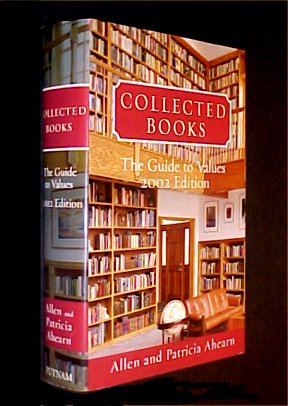
The first book I think you should consider putting on your shelf is Allen and Patricia Ahearn's Collected Books. The Guide to Values. 2002 Edition. If you can find it new in a bookstore, it'll cost you $75, but you should be able to find it used for about half that. Sometimes less. Though marketed primarily as a guide to values for over 20,000 first and important collected editions, what this book is most useful for is first edition identification. Suggested values for books can be marginally useful if they are up to date and based on real-life market results. These are over 2 years old, and if they are useful at all now it's for showing us relative value - the value of a given book relative to other books - and bringing the plums of book collecting into bold relief. However, there's much information in this book that is pointedly useful. For one thing, details on issue points, print numbers, and so on abound. Look at this entry for Crane's The Black Riders and Other Lines:
CRANE, Stephen. The Black Riders and Other Lines. Boston, 1895. Gray paper boards with first line of title on front cover indented one space to right has been presumed to be the first, but Pastore believes cream laid paper over yellow boards is the first. $1,500. There are variants in pail-yellow paper over boards, pale-yellow cloth (no known copies), gray laid paper (assume the "other first"), light-gray paper over boards (one known copy), and publisher leather (Williams & Starrett call for black morocco). We would assume all the variants would be about the same value as the first except the leather, which would be somewhat more. Plain boards, paper label. One of 50 copies in white paper over boards and printed in green ink on Japan vellum. $5,000. One of 3 copies bound in white vellum. $7,500. One of 3 copies bound in full green levant. $7,500. (For further detail see Stephen R. Pastore's bibliographical study of this title in Stephen Crane Studies vol. 6, no. 2 [Fall 1997].) London, 1896. 500 copies in black morocco. $1,250. Now this is detail, and it's exactly the kind of detail we need for accurate identification of edition states. Not all entries are this detailed - in fact many are much shorter (though Twain's Huckleberry Finn and others are longer). But in many cases brevity is sufficient because issue points aren't always, well, an issue. States can often be determined without them. No matter what, this book is an impressive piece of scholarship, and if you have any doubts about its authoritativeness, take a look at "Appendix A: Selected Bibliography of Works Consulted." 43 pages of listings! Approximately 1500 individual entries of bibliographies were consulted to put this book together. Very reassuring, I'd say, and knowing where to go for additional information, if necessary, is also useful. There's more. "Appendix B: First-Edition Identification By Publisher" consists of 17 pages of publisher-specific designation practices. Though not a complete list, all major publishing houses are represented, and this is probably all you could carry around in your head anyway. The conclusion? If you could only buy one book for first edition identification, this gets my vote. 2. First Editions: A Guide to Identification. Statements of selected North American, British Commonwealth, and Irish publishers on their methods of designating first editions. Edward N. Zempel and Linda A. Verkler, editors. The Spoon River Press. Peoria. 2001. Fourth edition. ISBN: 093035818X. 669 pp.
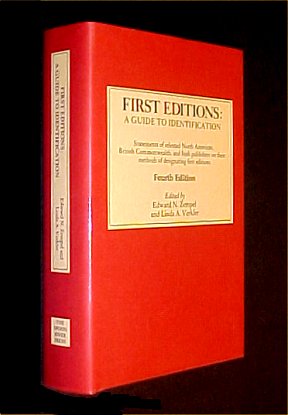
What distinguishes this book from all other first edition identification guides is that it's a largely unedited compilation of actual statements from publishers explaining how first editions are designated. Or, as stated in a Publisher's Weekly review: "Each publisher's reply on current used methods of citing editions is quoted verbatim ... from the horse's mouth." At first glance, this seems like a dream come true. What could be more definitive than a publisher's statement? And there are statements from over 4,200 of them! What could be more complete? Better yet, current methods and past methods are included, one and all, some of them dating back to 1928. Of course, there's the messy little business of variants and issue points which aren't covered in this book, but still, we have Collected Books for that, so this completes our first edition identification library, right? Not so fast. Take a look at this entry for Charles Scribner's Sons:
CHARLES SCRIBNER'S SONS At first glance this seems exceptionally detailed and complete, but my gosh, look at the qualifiers. In the 1928 statement: "We have no fixed plan for designating our first editions of general publications. If a book runs to more than one printing we usually print somewhere in the 'front matter' ..." No fixed plan? Usually? Well, usually isn't good enough if we're talking about a book that might be worth thousands. Unfortunately, this book is peppered with qualifiers, and perhaps the chilling "to my knowledge" appears more than any other. The truth is that many publishers aren't 100% certain that all first editions are designated in a certain manner, and why should they care? They are in the business of selling new books, not in the business of selling books that have become collectible long after their publication dates. Should you buy this book anyway? In my opinion, if money isn't an issue (this book is not cheap at $60 new, and buying it used will probably only save you a few bucks) yes. If you've been in the bookselling business long, you know only too well how much contention there is in the area of first edition identification, and having a publisher's statement may help confirm or at worst call into question an assertion you're having trouble swallowing in another source. Also, qualifiers aside, many of the publisher's statements in First Editions conform exactly to designations identified by dealers and collectors in other guides - that is, despite some ambiguity in publisher's statements, much of this is definitive. One more point before I move on to Bill McBride's books: over 4,200 publishers sounds complete, but it's not. McBride lists thousands himself, but there's much that doesn't overlap between the two books. Put the two books together, and you'll have information on approximately 6,000+ publishers. Reason enough to buy both? 3. A Pocket Guide to the Identification of First Editions. Bill McBride. McBride/Publisher. West Hartford, Connecticut. 2000. Sixth edition. ISBN: 0930313062. 112 pp.
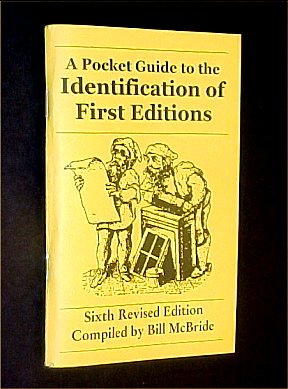
Probably the most popular of all first edition identification guides. McBride's approach is different than Zempel & Verkler's - and to some extent, the Ahearns', who are more dependent on bibliographic sources than actual field observation. Here is an explanation of his methodology from the introduction: "Using statements from the publishers as the sole basis of first edition identification is like walking with a single stilt: you have some support for your enterprise, but not enough to proceed with confidence. Publishers' statements are not necessarily wrong; in fact, they are usually correct, at the time they were written. But methods of identification change and his guide's editor decided to test the statements in the field rather than taking those statements as absolute truth. In addition, this guide seeks to determine when any given publisher may have changed its method." He then offers the following important qualifier: "Some exceptions to the methods here stated do exist; the purpose here is to help the collector, dealer, librarian and auctioneer to determine if a specific book is most likely a first edition. The phrase most likely is used because, now and then, a publisher may stray from its usual identification method, producing a book that is a first edition, but does not conform to the publisher's standard practice." I think it's important to make this qualification because so many exceptions do exist, and using general first edition identification guides may not always be enough. Sometimes they only narrow things down for us and point to possibilities. In any case, this guide, unlike some so-called pocketbooks, actually fits in your pocket (3 ¾" X 6") - a big plus - and it's readily referenced because keyed abbreviations are used to indicate designations. It's also very affordable - $12.95 new, and sometimes you can find copies for much less. Here's a sample page:
Hanging Loose Press: NAP Over 3,600 publishers are listed, and there's some excellent introductory/explanatory material in the introduction. Having used Ahearns', Zempel & Verkler's and McBride's guides for a number of years, I can confirm that there are a significant (but not huge) number of inconsistencies among them, as you would expect, but all are valuable sources notwithstanding. Given 3 different approaches to this topic, all 3 have something different to offer. And yes, I would definitely recommend putting McBride's book on your shelf alongside the other two. Again, issue points are not addressed in this book but are in McBride's other guide below. 4. Points of Issue: A Compendium of Points of Issue of Books by 19th-20ths Century Authors. Bill McBride. McBride/Publisher. West Hartford, Connecticut. 1996. Third edition, fourth printing. ISBN: 0930313046. 93 pp.
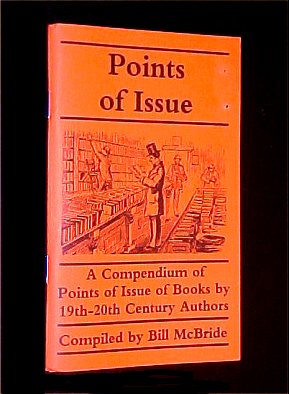
McBride's companion guide. McBride summarizes its contents succinctly in this blurb: "Lists over 1300 "points" (mistakes or conditions present that were corrected or changed, leaving two or more distinct states of the first printing of the first edition) in literary and other works. Tells where to look (page, line, etc.) and what to look for to identify these value-affecting textual and other properties." The information, he explains, was obtained from "dealer catalogs, bibliographies, and other source material variously available" and isn't intended to be exhaustive. The focus is on authors "whose track record established them as collectible." In additional to some useful explanatory material about points in the introduction, there is a very useful list of authors who have no known points. Checking this list first will enable you to go directly to publisher's designations in the other guide for confirmation of edition status. Entries in this guide are arranged by author name first, title second. A sample page:
Van Vechten, Carl. Music After the Great War. NY, 1915. B: lavender cloth, paper labels In my opinion, this is another essential reference guide, and at $12.95 new (less used), a bargain.
RecommendationsAs I mentioned, these 4 guides are the ones I use most often. With some patience, you should be able to get all of them for about $100. If money is tight, the next best thing is to pass on Zempel & Verkler's guide. This would get you down to about $40. Next best - Ahearn's only. About $25. There are 4 additional general guides to first edition identification that I believe are worth a look. 5. Book Collecting: The Book of First Books. Allen and Patricia Ahearn. Quill & Brush. Rockville, Maryland. 1986. Fourth edition. ISBN: 0961049472. 254 pp.
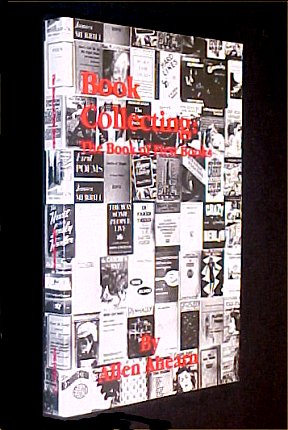
Another Ahearn entry. Though out of print for some time, this book can usually be found used for about $10. And, it's exactly what the title suggests - a book of author's first books, something in excess of 3,500 listings. Where applicable, issue points are included, also values, though the latter are hopelessly out of date. No second or later books make an appearance here, and the significance of this is that an author's first book is typically the most intensely collected and therefore also the most valuable. Familiarizing yourself with even a small percentage of these titles could pay significant dividends later on - and they have for me on several occasions. Not what I'd call an essential reference but definitely a potential gold mine of flashpoints. 6. 20th Century First Edition Classic Fiction: A Price and Identification Guide. Thomas Lee. Book Emporium Press. Rockville, Maryland. 2003. ISBN: 0965342964. 202 pp.
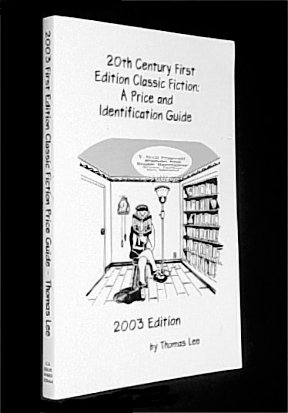
A guide to about 1,000 works of 64 of the 20th century's most collectible and popular fiction writers. Values are offered in 4 or more grade classifications and, in my opinion, seem to have some basis in present day reality. Detail on issue points is at times surprisingly rich, but the primary reason I often recommend this book, especially for beginning booksellers, is that it's manageably concise and focused on the fiction authors and titles most likely to be profitable to you as a book buyer. All 64 writers are collectible - flashpoints one and all. If you will write down (and perhaps memorize) the list of them that appears in the table of contents, then leaf through the book and write down, say, all titles for each author that exceed $75 or $100 in estimated value, and take this list with you on buying trips, you will have positioned yourself to begin making some great buys - and believe me, they will come. A bonus - brief biographies are also included. Reading these will help you keep the author's list firmly in mind. Lee lists this book continuously on eBay for about half what it sells for in bookstores - $15. 7. Guide to First Edition Prices: 2004/5. R.B. Russell, editor. Tartarus Press. United Kingdom. 2004. ISBN: 1872621783. 516 pp.
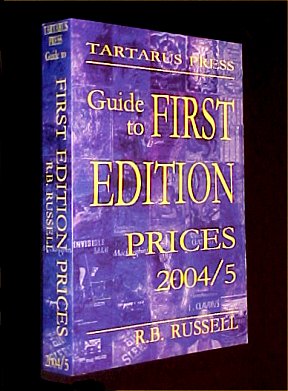
A British entry that has two important things going for it. First, it's the most up to date price guide I know of, and - some good news - it takes into account Internet prices. Estimated values, that is, have some basis in reality. Second, it's comprehensive. Over 600 collectible authors and 33,000 works are included - the biggest of all I've reviewed - along with (though not to the extent of other guides mentioned here) some issue points. Note that prices are quoted in Pounds Sterling, but it's relatively easy to make approximate conversions to dollars in your head. This is a difficult book to find in the US but is readily available at Amazon UK for $24.45. 8. American First Editions. Merle Johnson. Revised and enlarged by Jacob Blanck. R.R. Bowker Co. New York. 1942. 553 pp.
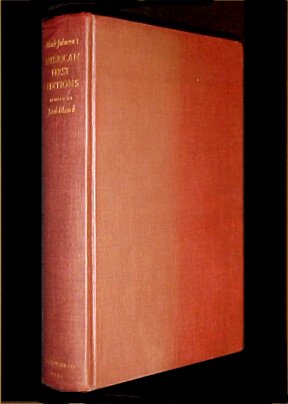
Long out of print but indisputably authoritative. A classic. (The Ahearn's cite AFE as a reference frequently in their guides.) Several hundred important American authors are included, as are first edition designations and, where applicable, issue points for 1,000's of titles published between the post-Revolutionary era and the mid 20th century. Also included are lists of biographical and bibliographical titles for many authors. IMPORTANT NOTE: BookThink recommends the 3rd and 4th editions. These were revised and greatly enlarged by legendary bibliographer Jacob Blanck. Expect to pay $30 and up for this. Some of these books are available for purchase on BookThink's BookShelf. If you'd prefer to buy used copies, your best bet for getting the best price is to enter the title in the FetchBook box on BookThink's BookSearch page.
< to previous article
Questions or comments?
| Forum
| Store
| Publications
| BookLinks
| BookSearch
| BookTopics
| Archives
| Advertise
| AboutUs
| ContactUs
| Search Site
| Site Map
| Google Site Map
Store - Specials
| BookHunt
| BookShelf
| Gold Edition & BookThink's Quarterly Market Report
| DomainsForSale
| BookThinker newsletter - free
Copyright 2003-2011 by BookThink LLC
|

|